Hiding Away In Harris...
An Ancient Scottish Isle of Crofters, Fishermen and Tweed-Weavers
by David Yeadon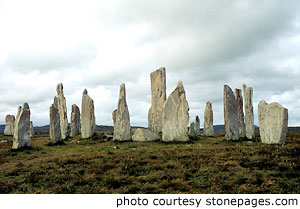 A primeval scene—no signs of habitation anywhere, no welcoming curls of smoke, no walls, no trees, no dainty patches of moorland flora here among the eroded stumps of archaean gneiss, breaking through the peat like old bones on an almost fleshless torso. On the wild moors of the Outer Hebrides island of Harris, I sheltered from a sudden storm in a hollow among the Earth's oldest rocks, formed more than 3 billion years ago, gouged and rounded in numerous ice ages, and sturdy enough to withstand many more.
A primeval scene—no signs of habitation anywhere, no welcoming curls of smoke, no walls, no trees, no dainty patches of moorland flora here among the eroded stumps of archaean gneiss, breaking through the peat like old bones on an almost fleshless torso. On the wild moors of the Outer Hebrides island of Harris, I sheltered from a sudden storm in a hollow among the Earth's oldest rocks, formed more than 3 billion years ago, gouged and rounded in numerous ice ages, and sturdy enough to withstand many more.
There's a Hebridean gaelic saying: "When God made time, he made plenty of it," and here, on the desolate summit of Clisham, at 2620', the highest point on Harris, you sense the infinitely slow passage of time. This is a fine place to know the insignificance of man and wonder if this is how the Earth may have looked at the very beginning.
And then—an abrupt transformation. The storm passes on, whirling out over the Sound of Shiant, heading for the dagger-tipped peaks of the black Cuillins on the isle of Skye, crouched on the eastern horizon. The air is suddenly sparkling, the sun warm, and far below is a scene that would seduce the most ardent admirer of tropical isles: great arcs of creamy shell-sand beaches, fringed by high dunes, and a turquoise-green ocean gently deepening to dark blue, lazily lapping on a shoreline unmarked by footprints for mile after mile on the great empty beaches of Luskentyre, Seilebost and Scarista.
"Aye—it's a magic place you're going to," said Hector Macleod at the Ceilidh Place pub in Ullapool, a bustling port-town of tiny whitewashed cottages overlooking Loch Broom on Scotland's west coast. "Some of the kindest people you'll ever meet – not pushy mind..." Hector paused and then winked—"Well—they've a bit of the magic too." The barman laughed. "They're Gaelic and Celtic—what can y'expect—they've all got the touch of magic in 'em!"
After the briefest of visits years ago I've been promising myself a more leisurely journey to these mysterious islands where the Scottish crofting families still weave the famous CloMor Harris tweed in their own homes.
"There's over 200 different islands out there," Hector continued, "and there was a time—not so very long ago too—when every one had its crofters and its own kirks. But then —well—a' might as well gi' y' a wee bit of our history. It's all bad stuff though an' a' suppose y'could blame a lot o' it on young Bonnie Prince Charlie and his Catholic-Jacobite rebellion in 1745. Now tha's a date no Scotsman will ever forget when Charles Edward came over from France and raised a big army in the highlands and islands to return the crown to his exiled Stuart family. It's a long, long story—there's a thousand books bin written 'bout it all—but it began right enough with Charlie battlin' his way down into England—as far as Derby can y' believe! But then it all went bad and he had a terrible defeat. Battle of Culloden, 1746. Near Inverness. An' remember that name—y'll be hearin' it over and over. Charlie escaped—y'know that story of Flora MacDonald helpin' him and that song, the Skye Boat song—y'know—'Sail bonnie boat, like a boat on the wing, over the sea to Skye.' But after that the English came up and tore Scotland apart. The Duke of Cumberland—'The Butcher' they called him—wiped out the whole clan system, burnt down towns and villages and made the highlands a wasteland. Oh aye it was a bad, bad time alright—and so t'was for the next hundred years an' more. Too many people trying to live on tiny bits of poor land—all outcasts of the great lairdic feasts—then all those terrible famines—the potato famines—the collapse o' the island kelp industry—they burnt it y'know to produce alkali. Valuable stuff then... 'and all these great 'clearances' in the late 1800s when the big lairds got together, kicked s' many people off the land—bundled them off to Canada and Australia and suchlike places—and moved the sheep in. Now I think there's only 10 islands—maybe less—with any people at all. Crofting's a hard life. Always has been—but now it's dyin'."
I thanked Hector for his succinct—if depressing—summary of Scottish history and ordered drinks for both of us.
"Well—cheers t' you for that," he said and began again. "But you know, in spite of it all, life goes on out there. Sometimes though you wonder how much bad luck th' can take. A' mean look at what happened jus' recent—'specially that Chernobyl thing—y'know the nuclear power station mess in Russia. They had to destroy the sheep on Harris 'cause of fallout. And that BCCI bank that went belly up and took all the Western Isles money with it—twenty odd million. Everything they had. And then the herring—that's pretty much finished with all those Spanish an' Japanese an' English trawlers overfishin'—and, would y' believe—even the tweed itself—the great cloth of Harris and Lewis—that seems to'be dying out now too..."
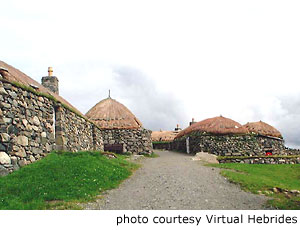 A frisky three-hour ferry ride from Ullapool brought me—a little shaken by both the turbulent journey and Hector's revelations—to Stornoway, capital of the 130-mile-long Outer Hebrides chain. This small town of 8600 people is the hub of activity on the main island of Lewis and Harris, and the epitome of all the best and worst of island life. Fine churches, big Victorian houses, lively industries, new hotels, even a mock castle and a colorful fishing fleet mingle with bars, poolhalls, fish and chip shops and, according to one local church newspaper, "palaces of illicit pleasures whose value to the community is highly questionable"—referring to the town's two rather modest discos.
A frisky three-hour ferry ride from Ullapool brought me—a little shaken by both the turbulent journey and Hector's revelations—to Stornoway, capital of the 130-mile-long Outer Hebrides chain. This small town of 8600 people is the hub of activity on the main island of Lewis and Harris, and the epitome of all the best and worst of island life. Fine churches, big Victorian houses, lively industries, new hotels, even a mock castle and a colorful fishing fleet mingle with bars, poolhalls, fish and chip shops and, according to one local church newspaper, "palaces of illicit pleasures whose value to the community is highly questionable"—referring to the town's two rather modest discos.
Stornoway's stern Calvinistic appearance was no great inducement to dallying so I was soon off across the bleak moors and peat bogs looking for the tweedmakers in the heart of Harris. Then I paused for a while to climb Clisham, and that's how I got stuck in the storm.
But as the weather cleared, I came down slowly from the wind-blasted tops and could see, far below, the thin crofting strips on the fertile 'machair' land—a unique and rich blending of soil and blown sand fringing the coastal cliffs and dunes.
They say the milk of cows grazed on the machair in the spring and summer is scented by the abundance of its wild flowers—primroses, sea spurrey, campion, milkwort, seapink, sorrel and centaury. Each strip, usually no more than six acres in all, once had its own steep-gabled crofter's cottage set close to the narrow road, which wound around the boulders and burns. Behind each of the cottages lurked the sturdy remnants of older homes, the notorious "black houses" or tigh dubh. Some were mere walls of crudely shaped bedrock, four feet thick in places: others were still intact as if the family had only recently moved out. They were roofed in thick thatch made from barley stalks, held in place by a grid of ropes, weighted down with large rocks. Windows were tiny, set deep in the walls, and door openings were supported by lintel stones over two feet thick. Nearby were dark brown piles of peats, the "cruachs", enough to heat a house for a whole year.
Looking at these black houses, which until recently formed the communal living space for families and their livestock, you feel pulled back in time to the prehistoric origins of island life, long before the invasions of the Icelandic tribes and the Norsemen from Scandinavia, long before the emergence of the Celtic clans of the MacAulays, MacRaes, and the ever-dominant MacLeods. All around the islands are remnants of ancient cultures in the form of brochs (lookout towers), Bronze Age burial mounds, stone circles and the famous standing stones of Callanish on Lewis, thought to have been a key ceremonial center for island tribes since 2000 BC. The ponderous tigh dubh houses seem very much of this heritage and I experienced a strange sense of 'coming home' again to something half remembered, deep deep down, far below the frimperies and facades of everyday 'modern' life. Something that sent shivers to my toes.
Lord Seaforth, one of the islands' numerous wealthy 'utopian benefactors' during the last couple of centuries, was anxious to improve "the miserable conditions under which these poor scraps of humanity live" and ordered that "at the very least a chimney should be present and a partition erected between man and beast in these dark hovels." But apparently some of the crofters were quite content to share their living space with their own livestock. They also considered the quality of peat soot vastly superior as fertilizer for their tiny 'lazybed' potato plots when the smoke was allowed to find its own way through the thatch from the open hearthstone fire in the center of the earthen floor.
But despite such conditions, the crofters were known for their longevity and prolific families. Dr. Samuel Johnson, accompanied on an island tour by the ever-faithful Boswell in 1773, put it down to island breakfasts. "If an epicure could remove himself by a wish," Dr. Johnson remarked, "he would surely breakfast in Scotland." I concur wholeheartedly. My first real Scottish breakfast came at Katie MacAskill's Ardhasaig House overlooking West Loch tarbert on North Harris and included such traditional delights as fresh oatmeal porridge, smoked herring 'kippers,' peat-smoked bacon, black pudding, white pudding, just-picked mushrooms and tomatoes, free-range eggs, oatcakes, bannock cakes, scones, honey, crowdie (a deliciously rich cream cheese), and cream-everything in fact except the once-customary tumbler of island whisky, "to kindle the fire for the day."
"Oh, the breakfasts are still very fine," agreed Mary MacDonald, postmistress of Leverburgh village, when I later sat by her blazing peat fire drinking tea and nibbling her homemade buttery shortbread. "The world's getting smaller everywhere," she told me. "Things are changin' here too—we talk in gaelic about an saoghal a dh'fhalbh —'the world we have lost'—but y' can always find a good breakfast!"
I wondered about all these changes (hoping she might be a little more optimistic than Hector in Ullapool).
"Well, we're losing a lot of the young ones, that's always a big problem. But those that stay still work at the crofting and keep up the gaelic." She paused. "I miss the old ceilidhs most I think—we used to gather at the ceilidh house to talk about local things and listen to the old tales by the seannaicheadh—an elder village storyteller. Now they're a bit more organized—more of a show at the pubs with poems and songs and such. Not quite the same."
I asked about the famous Harris tweed-makers of the islands. "Oh, you'll still find some of them—used to be more than 400 I think—making it the old way in their own homes on the Hattersley looms. You can usually hear the shuttles clacking way back up the road."
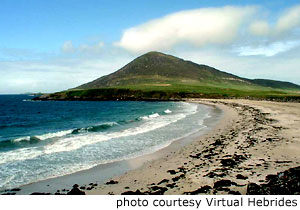 Mary was right. On an earlier, and very brief visit here, I went looking for Marion Campbell, one of Harris' most reknowned weavers, who lived in the tiny village of Plocrapool (not the easiest place to find as all the signposts are in Gaelic!) on the wild eastern side of the island, where the moors end dramatically in torn cliffs and little ragged coves. And I heard the urgent clatter of her loom echoing against the bare rocks long before I found her house, nestled in a hollow overlooking an islet-dotted bay. Through a dusty window of the weaving shed I saw an elderly woman with white hair working at an enormous wooden contraption.
Mary was right. On an earlier, and very brief visit here, I went looking for Marion Campbell, one of Harris' most reknowned weavers, who lived in the tiny village of Plocrapool (not the easiest place to find as all the signposts are in Gaelic!) on the wild eastern side of the island, where the moors end dramatically in torn cliffs and little ragged coves. And I heard the urgent clatter of her loom echoing against the bare rocks long before I found her house, nestled in a hollow overlooking an islet-dotted bay. Through a dusty window of the weaving shed I saw an elderly woman with white hair working at an enormous wooden contraption.
"Aye, come in now and mind the bucket."
The bucket was on the earth floor crammed in between a full-size fishing dinghy, lobster pots, a black iron cauldron, cans of paint, and a pile of old clothes over the prow of the boat, just by a crackling peat fire which gave off a wonderful "peat-reek" aroma.
"You can always tell a real Harris tweed," Marion told me. "There's always a bit of the peat-reek about it."
She worked her loom at an alarming pace and the shed shook as she whipped the shuttle backwards and forwards between the warp yarns with bobbins of blue weft. I watched the blue-green tweed cloth, precisely thirty-one inches wide with "good straight edges and a tight weave" grow visibly in length as her feet danced across the pedals of the loom and her left hand "beat up" the weft yarns, compacting them with her thick wooden weaver's beam. Then her sharp eyes, always watching, spotted a broken warp yarn. 'Och! I've been doing this for 59 years and I still get broken ones!" She laughed and bounced off her bench, which was nothing more than a plank of wood wrapped in a bit of tartan cloth to fix the errant thread. "And mind that bucket."
I looked down and saw it brimming with bits of vegetation, the color of dead skin and about as attractive. "That's crotal. Lichen—from the rocks. For my dyes." In the days before chemical dyes most spinners and weavers made their own from moorland plants and flowers—heather, bracken, irises, ragwort, marigolds, whatever was available.
"I'm one of the last ones doing it now," Marion told me. "By law all Harris tweed has to be hand-woven in the weaver's own home on the islands here from Scottish virgin wool, but I'm doing it the really old way—dyeing my own fleeces, carding, making my own yarn, spinning, weaving—I even do my own 'waulking' to clean the tweed and shrink it a bit. That takes a lot of stamping about in Wellington boots!"
I pointed to a pile of tan-colored fleece and asked if it had been dyed with the lichen. Marion giggled, "Oooh—no, no, that's the peat—the peat soot. Makes a lovely shade." I suppose I looked skeptical. "Wet your finger," she told me, so I did and she plunged it into a pot of soot by the boat. "Now rub it off." I obeyed again and—surprise—a yellow finger! Her laughing made the shed shake. "Aye, you'll be stuck with that now for a while." Three days actually.
Later I sat by her house overlooking the Sound of Shiant as Marion spun new yarn for her bobbins. On an average day she weaves a good ten yards of tweed. "I do all the main patterns—herringbone, bird's eye, houndstooth, 2 by 2. I like the herringbone. It always looks very smart."
On the hillside above the house I could see a crofter walking among his new lambs in the heather: out in the sound another crofter was hawling his lobster pots or 'creels' as they call them here.
"You're a bit of everything as a crofter," Marion told me as her spinning wheel hummed. "You're a shepherd, a fisherman, a gardener, you collect your seaweed for fertilizer, you weave, build your walls, cut and dry your peats, shear your sheep at the fank, cut hay, dig ditches—a bit of everything. In the past you'd leave the croft and go to your 'shieling' in the summer to graze the cows and each night or each week—depending on the distance—the girls would carry the milk back to make butter cheese and 'crowdie. Och—I remember that so well. Lovely times..."
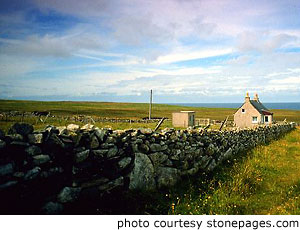 And I remember her so well now, despite the fact that she passed away quite a few years ago and her cousin, Katie and daughter Katherine, maintain the family weaving tradition at their own looms in a nearby house. On Harris you use what's at hand. In the last century there were well-intentioned but often eccentric schemes to 'improve' this lonely island suffering from signs of terminal decline. One German inventor, Gerhard Zucher, failed gloriously, with an epic explosion, to promote "mail by rocket" as a way of speeding up the delivery of goods between the islands. The soap industry magnate, Lord Leverhulme, who purchased Lewis and Harris in the early 1900s, tried to establish a major port at Leverburgh (it flopped), to make sausages for African nations from surplus whale meat (ditto), and even built an elaborate mill to increase the efficiency of the tweed industry (likewise ditto). Lady Dunmore, whose family built the grandiouse baronial Amhuinnsuidhe Castle here in 1868, was more successful in her efforts to enhance the tweed industry by organizing the cottage-based system.
And I remember her so well now, despite the fact that she passed away quite a few years ago and her cousin, Katie and daughter Katherine, maintain the family weaving tradition at their own looms in a nearby house. On Harris you use what's at hand. In the last century there were well-intentioned but often eccentric schemes to 'improve' this lonely island suffering from signs of terminal decline. One German inventor, Gerhard Zucher, failed gloriously, with an epic explosion, to promote "mail by rocket" as a way of speeding up the delivery of goods between the islands. The soap industry magnate, Lord Leverhulme, who purchased Lewis and Harris in the early 1900s, tried to establish a major port at Leverburgh (it flopped), to make sausages for African nations from surplus whale meat (ditto), and even built an elaborate mill to increase the efficiency of the tweed industry (likewise ditto). Lady Dunmore, whose family built the grandiouse baronial Amhuinnsuidhe Castle here in 1868, was more successful in her efforts to enhance the tweed industry by organizing the cottage-based system.
The main town of Tarbert (Tairbart in Gaelic), with a population of 500 huddled in fishing cottages around a small quay, is hardly anyone's idea of a Hebridean hot spot. The community of Rodel (Roghadal) possesses a sturdy 16th-century church with ornately carved tombs of the MacLeod chieftains, and there are a few notable hostelries on the island such as Scarista House and Ardhasaig House. You might also catch glimpses of red deer, otters, seals, golden eagles, and even the occasional dolphin off the Bays. But none of these are the true appeal of this place.
So what is the lure?
Try silence, wilderness, solitude, dramatic soul-nurturing scenery and a sense of coming home to something bold, basic, and honest—things that endure warmly in your memory.
I remember so many moments on these islands—some sad; all revealing. I remember the shepherd, Alistair Gilis, recently returned after years of adventure in the merchant navy, only to lose a third of his ewes in this year's long cold winter and spring. "You can't win in a place like this," he told me with gaelic melancholy. "All you can do is pass y' time here. Just pass y' time as best you can."
And then I remember Tim and Patricia Martin's honest island cuisine at their Scarista House Hotel where you dine on Harris crayfish, lobster, venison, salmon or grouse (whatever is fresh that day) as the sun goes down in a blaze of scarlet and gold over the white sands of Taransay Sound. And then the two Johnnys—the brothers MacLeod—on "the first good day at the peats in nine months" slicing the soft chocolatey peat with their irons into even-sized squares for drying. I talked with them at dusk as they moved rhythmically together along their family peat bank (their piece of "skinned earth"). "Another eight days like this should see enough for the year," the elder Johnny remarked, still slicing. The younger Johnny nodded and eyed the whisky bottle half hidden in a nearby sack. "Not jus' yet," said the first Johnny. The second Johnny grunted and lifted his fifteen hundredth peat of the day.
I remember the Sunday silences too when no buses run and everyone was 'at the stones' (at church); I remember the colors of Calum MacAulay's tweeds produced in his weaving shed—all the tones of the lochans and the rocks and the moors captured in his sturdy cloth; I remember Catherine MacDonald knitting her highly-praised woolen cardigans and jumpers from hand-dyed island wool; the stooping winkle-pickers of Leverburgh whose sacks of tiny shellfish leave the island by ferry for the tables of famous Paris restaurants; the first taste of fresh-boiled island langoustines; 93 year old Donald MacLeod carving sheep horns into elegant handles for shepherd's crooks; the sight of a single palm tree against the enormous lunar wilderness of Harris (the offshore Gulf Stream keeps the climate mild here). Then I remember Derrick Murray at his tweed mill in Shawbost eyeing with pride the tweeds collected from the homes of his crofter-weavers; the strange conversations in "ganglish"—an odd mix of gaelic and English; the 10 lovely lilting names of tiny islets in the Sound of Harris—Shillay, Coppay, Tahay, Ensay, Pabbay; the huge Blackface rams on the machair land with their triple-curl horns; the gritty and occasionally grim Calvinistic Protestantism of Lewis compared with the Catholic-Celtic levity of the Uist and Barra islanders in the southern part of the Hebridean chain.
And I remember most of all that Hebridean light—sparkling off the turquoise bays, crisping the edges of the ancient standing stones of Callanish on a lonely plateau overlooking Loch Roag, making all the colors vibrant with its intensity and luminosity—making the place just the way I knew it would be...
Magic.
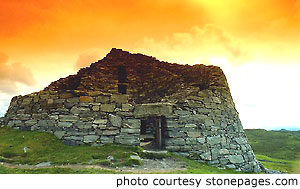 But today, as I quickly learned during this extended visit, things are rather different from my first experiences. The magic still remains but Harris hangs ever more precariously on the cusp of a dying culture. Despite the islanders' determination to keep their Gaelic heritage and traditions, the strict Calvinistic underpinnings of their faith, and their tiny shards of rock-rough land, their predicament is perilous. True crofting has virtually vanished now, the once teeming shoals of herring have long gone and fishing is limited mainly to shellfish, occasional runs of cod and ling, and salmon farming. Added threats to the old ways encompass the increasingly rapid and usually lifelong out-migration of the younger generation to the job-rich mainland cities of Edinburgh, Aberdeen, Glasgow and Inverness: the burgeoning arrival of 'incomers' (also derisively labeled 'white settlers') particularly from the affluent fleshpots of England's southern counties which has driven up real estate prices here far beyond local affordability, and of course—most sadly of all—the ongoing decline of that once great, hand-woven tweed cottage industry.
But today, as I quickly learned during this extended visit, things are rather different from my first experiences. The magic still remains but Harris hangs ever more precariously on the cusp of a dying culture. Despite the islanders' determination to keep their Gaelic heritage and traditions, the strict Calvinistic underpinnings of their faith, and their tiny shards of rock-rough land, their predicament is perilous. True crofting has virtually vanished now, the once teeming shoals of herring have long gone and fishing is limited mainly to shellfish, occasional runs of cod and ling, and salmon farming. Added threats to the old ways encompass the increasingly rapid and usually lifelong out-migration of the younger generation to the job-rich mainland cities of Edinburgh, Aberdeen, Glasgow and Inverness: the burgeoning arrival of 'incomers' (also derisively labeled 'white settlers') particularly from the affluent fleshpots of England's southern counties which has driven up real estate prices here far beyond local affordability, and of course—most sadly of all—the ongoing decline of that once great, hand-woven tweed cottage industry.
Despite a plethora of investments, some more insightful than others, by the Western Isles Council and other well-intentioned organizations in a wide range of infrastructural and seed-industry projects, and recent initiatives for the creation of a huge rock quarry (defeated) and vast wind turbine 'farms' on the Lewis moors (pending), the supportive pillars of the once-unique Harris lifeways are still being eaten away by the voracious termites of twenty-first century realities.
And yet... and yet...
All is not quite lost. Out here, on the edge of the world, not everyone, despite the gloom-and-doom-sayers, has given up on an authentic and optimistic future for the island. Recent events—miraculous to some—particularly with regard to a revival of the great Clo Mor tweed industry here, suggest that new possibilities, new initiatives and synchronicities, may still revitalize the looms and lives of the weavers and restore balance and harmony to the future of this "Little Island that Could..." Most notable was the huge order for tweed from Nike used to create a unique 'limited edition, retro-revival' sneaker which apparently was so popular that it vanished from store shelves virtually overnight. Other similar initiatives and projects are currently pending and scores of home-based tweed weavers are now back at their looms...
And so, tweed may yet be the key, once again, to island survival... and what a fine, uplifting, heart-warming story that would make...

